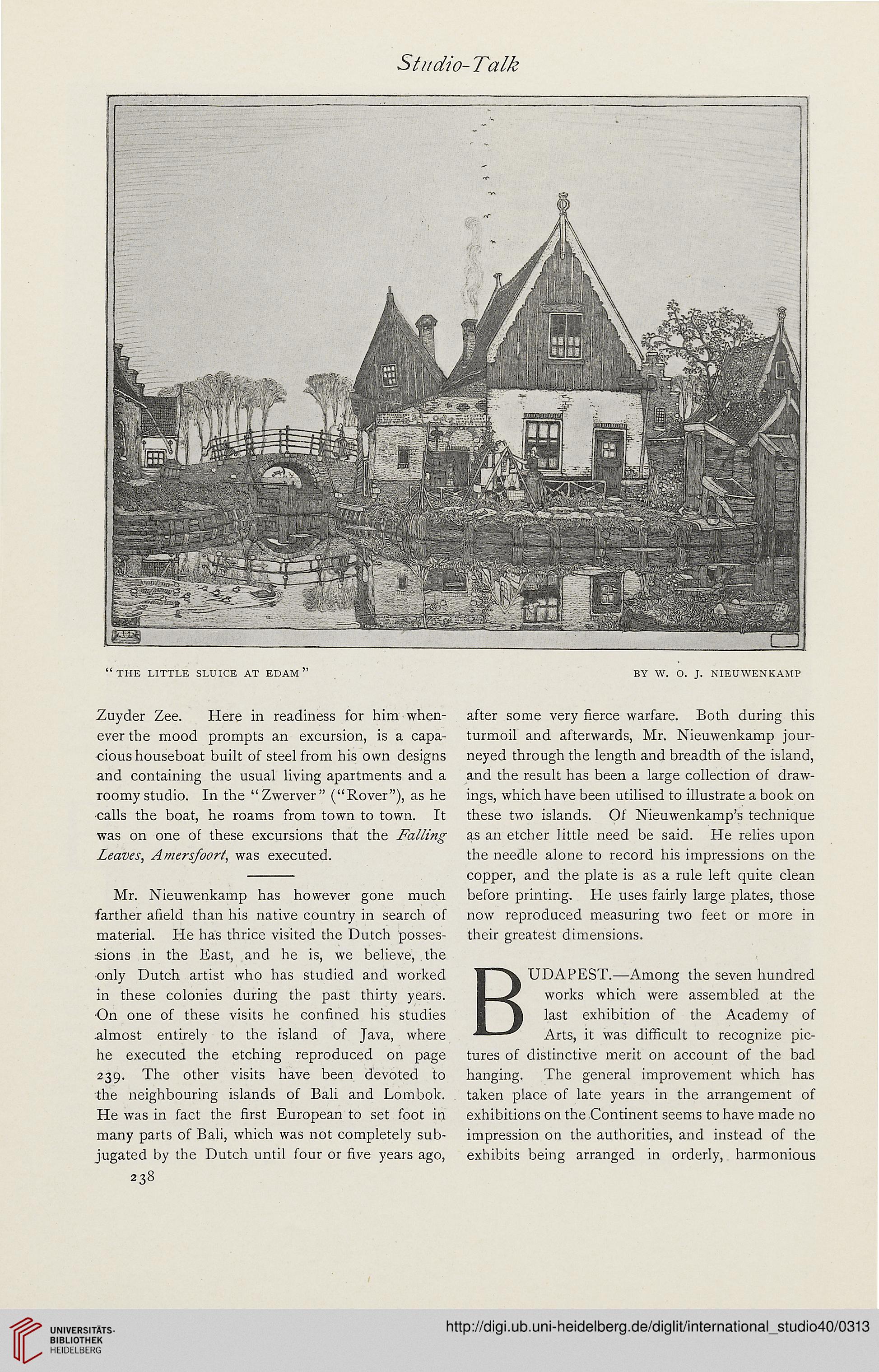Studio- Talk
Zuyder Zee. Here in readiness for him when-
ever the mood prompts an excursion, is a capa-
cious houseboat built of steel from his own designs
and containing the usual living apartments and a
roomy studio. In the "Zwerver" ("Rover"), as he
calls the boat, he roams from town to town. It
was on one of these excursions that the Falling
Leaves, Ainersfoort, was executed.
Mr. Nieuwenkamp has however gone much
farther afield than his native country in search of
material. He has thrice visited the Dutch posses-
sions in the East, and he is, we believe, the
only Dutch artist who has studied and worked
in these colonies during the past thirty years.
On one of these visits he confined his studies
.almost entirely to the island of Java, where
he executed the etching reproduced on page
239. The other visits have been devoted to
the neighbouring islands of Bali and Lombok.
He was in fact the first European to set foot in
many parts of Bali, which was not completely sub-
jugated by the Dutch until four or five years ago,
238
after some very fierce warfare. Both during this
turmoil and afterwards, Mr. Nieuwenkamp jour-
neyed through the length and breadth of the island,
and the result has been a large collection of draw-
ings, which have been utilised to illustrate a book on
these two islands. Of Nieuwenkamp's technique
as an etcher little need be said. He relies upon
the needle alone to record his impressions on the
copper, and the plate is as a rule left quite clean
before printing. He uses fairly large plates, those
now reproduced measuring two feet or more in
their greatest dimensions.
BUDAPEST.—Among the seven hundred
works which were assembled at the
last exhibition of the Academy of
Arts, it was difficult to recognize pic-
tures of distinctive merit on account of the bad
hanging. The general improvement which has
taken place of late years in the arrangement of
exhibitions on the Continent seems to have made no
impression on the authorities, and instead of the
exhibits being arranged in orderly, harmonious
Zuyder Zee. Here in readiness for him when-
ever the mood prompts an excursion, is a capa-
cious houseboat built of steel from his own designs
and containing the usual living apartments and a
roomy studio. In the "Zwerver" ("Rover"), as he
calls the boat, he roams from town to town. It
was on one of these excursions that the Falling
Leaves, Ainersfoort, was executed.
Mr. Nieuwenkamp has however gone much
farther afield than his native country in search of
material. He has thrice visited the Dutch posses-
sions in the East, and he is, we believe, the
only Dutch artist who has studied and worked
in these colonies during the past thirty years.
On one of these visits he confined his studies
.almost entirely to the island of Java, where
he executed the etching reproduced on page
239. The other visits have been devoted to
the neighbouring islands of Bali and Lombok.
He was in fact the first European to set foot in
many parts of Bali, which was not completely sub-
jugated by the Dutch until four or five years ago,
238
after some very fierce warfare. Both during this
turmoil and afterwards, Mr. Nieuwenkamp jour-
neyed through the length and breadth of the island,
and the result has been a large collection of draw-
ings, which have been utilised to illustrate a book on
these two islands. Of Nieuwenkamp's technique
as an etcher little need be said. He relies upon
the needle alone to record his impressions on the
copper, and the plate is as a rule left quite clean
before printing. He uses fairly large plates, those
now reproduced measuring two feet or more in
their greatest dimensions.
BUDAPEST.—Among the seven hundred
works which were assembled at the
last exhibition of the Academy of
Arts, it was difficult to recognize pic-
tures of distinctive merit on account of the bad
hanging. The general improvement which has
taken place of late years in the arrangement of
exhibitions on the Continent seems to have made no
impression on the authorities, and instead of the
exhibits being arranged in orderly, harmonious




